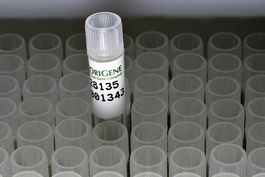Glutathione Peroxidase 2 (GPX2) (NM_002083) Human Tagged ORF Clone
CAT#: RG209365
- TrueORF®
GPX2 (GFP-tagged) - Human glutathione peroxidase 2 (gastrointestinal) (GPX2), (10ug), (Note: selenocysteine protein, Internal stop codon present. see reference data summary below)
"NM_002083" in other vectors (4)
Product Images

Specifications
| Product Data | |
| Type | Human Tagged ORF Clone |
| Symbol | GPX2 |
| Synonyms | GI-GPx; GPRP; GPRP-2; GPx-2; GPx-GI; GSHPx-2; GSHPX-GI |
| Vector | pCMV6-AC-GFP |
| E. coli Selection | Ampicillin (100 ug/mL) |
| Mammalian Cell Selection | Neomycin |
| Sequence Data |
>RG209365 representing NM_002083
Red=Cloning site Blue=ORF Green=Tags(s) TTTTGTAATACGACTCACTATAGGGCGGCCGGGAATTCGTCGACTGGATCCGGTACCGAGGAGATCTGCC GCCGCGATCGCC ATGGCTTTCATTGCCAAGTCCTTCTATGACCTCAGTGCCATCAGCCTGGATGGGGAGAAGGTAGATTTCA ATACGTTCCGGGGCAGGGCCGTGCTGATTGAGAATGTGGCTTCGCTCTGAGGCACAACCACCCGGGACTT CACCCAGCTCAACGAGCTGCAATGCCGCTTTCCCAGGCGCCTGGTGGTCCTTGGCTTCCCTTGCAACCAA TTTGGACATCAGGAGAACTGTCAGAATGAGGAGATCCTGAACAGTCTCAAGTATGTCCGTCCTGGGGGTG GATACCAGCCCACCTTCACCCTTGTCCAAAAATGTGAGGTGAATGGGCAGAACGAGCATCCTGTCTTCGC CTACCTGAAGGACAAGCTCCCCTACCCTTATGATGACCCATTTTCCCTCATGACCGATCCCAAGCTCATC ATTTGGAGCCCTGTGCGCCGCTCAGATGTGGCCTGGAACTTTGAGAAGTTCCTCATAGGGCCGGAGGGAG AGCCCTTCCGACGCTACAGCCGCACCTTCCCAACCATCAACATTGAGCCTGACATCAAGCGCCTCCTTAA AGTTGCCATA ACGCGTACGCGGCCGCTCGAG - GFP Tag - GTTTAA >RG209365 representing NM_002083
Red=Cloning site Green=Tags(s) MAFIAKSFYDLSAISLDGEKVDFNTFRGRAVLIENVASL*GTTTRDFTQLNELQCRFPRRLVVLGFPCNQ FGHQENCQNEEILNSLKYVRPGGGYQPTFTLVQKCEVNGQNEHPVFAYLKDKLPYPYDDPFSLMTDPKLI IWSPVRRSDVAWNFEKFLIGPEGEPFRRYSRTFPTINIEPDIKRLLKVAI TRTRPLE - GFP Tag - V |
| Restriction Sites |
SgfI-MluI
Cloning Scheme for this gene
Plasmid Map

|
| ACCN | NM_002083 |
| OTI Disclaimer | The molecular sequence of this clone aligns with the gene accession number as a point of reference only. However, individual transcript sequences of the same gene can differ through naturally occurring variations (e.g. polymorphisms), each with its own valid existence. This clone is substantially in agreement with the reference, but a complete review of all prevailing variants is recommended prior to use. More info The expression of this clone is not guaranteed due to the nature of selenoproteins. |
| OTI Annotation | This clone encodes a selenoprotein containing the rare amino acid selenocysteine (Sec). Sec is encoded by UGA codon, which normally signals translational termination. Expression of this clone is not guaranteed due to the nature of selenoproteins. |
| Product Components | The ORF clone is ion-exchange column purified, transfection-ready dried plasmid DNA, and shipped with 2 vector sequencing primers. |
| Reconstitution | 1. Centrifuge at 5,000xg for 5min. 2. Carefully open the tube and add 100ul of sterile water to dissolve the DNA. 3. Close the tube and incubate for 10 minutes at room temperature. 4. Briefly vortex the tube and then do a quick spin (less than 5000xg) to concentrate the liquid at the bottom. 5. Store the suspended plasmid at -20°C. The DNA is stable for at least one year from date of shipping when stored at -20°C. |
| Reference Data | |
| RefSeq | NM_002083.2, NP_002074.2 |
| RefSeq Size | 1024 bp |
| RefSeq ORF | 573 bp |
| Locus ID | 2877 |
| Cytogenetics | 14q23.3 |
| Protein Families | Druggable Genome |
| Protein Pathways | Arachidonic acid metabolism, Glutathione metabolism |
| Gene Summary | 'The protein encoded by this gene belongs to the glutathione peroxidase family, members of which catalyze the reduction of organic hydroperoxides and hydrogen peroxide (H2O2) by glutathione, and thereby protect cells against oxidative damage. Several isozymes of this gene family exist in vertebrates, which vary in cellular location and substrate specificity. This isozyme is predominantly expressed in the gastrointestinal tract (also in liver in human), is localized in the cytoplasm, and whose preferred substrate is hydrogen peroxide. Overexpression of this gene is associated with increased differentiation and proliferation in colorectal cancer. This isozyme is also a selenoprotein, containing the rare amino acid selenocysteine (Sec) at its active site. Sec is encoded by the UGA codon, which normally signals translation termination. The 3' UTRs of selenoprotein mRNAs contain a conserved stem-loop structure, designated the Sec insertion sequence (SECIS) element, that is necessary for the recognition of UGA as a Sec codon, rather than as a stop signal. Alternatively spliced transcript variants have been found for this gene. [provided by RefSeq, Jul 2016]' |
Documents
| Product Manuals |
| FAQs |
Resources
Other Versions
| SKU | Description | Size | Price |
|---|---|---|---|
| SC324551 | GPX2 (untagged)-Human glutathione peroxidase 2 (gastrointestinal) (GPX2) (10ug), (Note: selenocysteine protein, Internal stop codon present. see reference data summary below) |
USD 420.00 |
|
| RC209365 | GPX2 (Myc-DDK-tagged)-Human glutathione peroxidase 2 (gastrointestinal) (GPX2), (Note, selenocysteine protein, internal stop codon, see reference data summary) |
USD 98.00 |
|
| RC209365L3 | Lenti-ORF, GPX2 (Myc-DDK-tagged)-Human glutathione peroxidase 2 (gastrointestinal) (GPX2), (Note, selenocystein protein, internal stop codon, see summary) |
USD 620.00 |
|
| RC209365L4 | Lenti-ORF, GPX2 (mGFP-tagged) - Human glutathione peroxidase 2 (gastrointestinal) (GPX2), (Note: selenocystein protein, Internal stop codon present. See Summary below) |
USD 620.00 |
{0} Product Review(s)
Be the first one to submit a review






























































































































































































































































 Germany
Germany
 Japan
Japan
 United Kingdom
United Kingdom
 China
China
